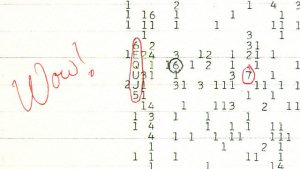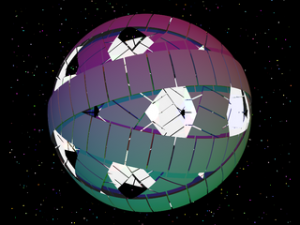Proving that there is still much about the universe we don’t know, the Wow! signal from 1977 confounds to this day. So what is the Wow! signal, and why is it still of interest roughly 40 years later?
the universe we don’t know, the Wow! signal from 1977 confounds to this day. So what is the Wow! signal, and why is it still of interest roughly 40 years later?
Should another civilization somewhere in the universe want to communicate with us and announced their presence, it is theorized that these alien beings will most likely broadcast at 1420 megahertz (MHz), a natural emission frequency of hydrogen. The thinking is that given hydrogen’s natural abundance in the universe, all intelligent creatures will be aware of it and therefore attempt to communicate at this natural emission line. So back in the 1970s, when Ohio State University was re-purposing the Big Ear telescope in Delaware, Ohio to help with SETI, the telescope was tuned to watch the 1420 MHz frequency.
Big Ear was set to scan the sky in 72 second intervals, changing locations scanned after that time due to the earth’s rotation. The signal was only heard on a single frequency with no accompanying static on surrounding frequencies. A signal created from something in nature would normally be expected to have static along with the signal.
The signal also “rose and fell” during the 72 seconds, as would be expected from something originating in space. When the radio telescope is pointed at the sky, any such signal will appear to increase in intensity as it first moves across the observational beam of the telescope, then peak when the telescope is pointed straight at it and then decrease as it moves away from the telescope. This also makes a mere computer glitch a less likely explanation, although not impossible.
Subsequent checks in the same approximate area for additional signals have turned up nothing. So we haven’t seen anything that helps us determine for certain if this is a natural “noise” from elsewhere in the universe or if it was created by another intelligent species.
However, recently Professor Antonio Paris of St. Petersberg College in Florida has put forward a hypothesis as to what the Wow! signal really is. He believes it could have been reflections from one of two comets believed to be in the area of the Big Ear’s orientation back in 1977. And he’s crowdfunding the money needed to test his hypothesis.
Comet 266P/Christensen will pass the Chi Sagittarii star group again on 25 January 2017, while 335P/Gibbs will make its passage on 7 January 2018. Paris plans to observe these events to look for a recurrence of the mystery signal. But time is not on his side for using an existing radio telescope – they are all booked out.
So by this time next year we should be able to tell if Professor Paris is right or not. Look for a follow-up then. In the meantime, if you’d like to hear more about the Wow! signal, I recommend a read or listen to the Skeptoid Wow! episode which better covers much of what we know or think we know about the signal.


